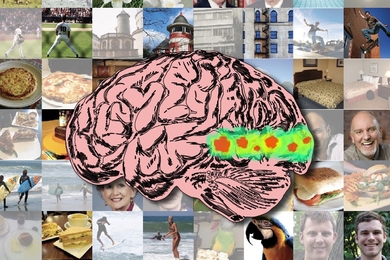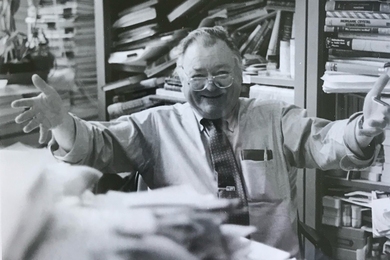Likening them to the Pilgrims who arrived in Massachusetts in the early 1600s, Professor John Vander Sande welcomed the first Cambridge students to the Cambridge-MIT Institute (CMI) program Monday.
The 33 third-year students from the University of Cambridge will be spread across seven departments during their year at MIT. Twenty-seven MIT juniors will spend the year at Cambridge in the United Kingdom.
'We've all been waiting for this moment," said Vander Sande, MIT director of CMI. Noting that the undergraduate exchange is "in many people's opinion the most important part of the program," he said to the English students, "You'll learn a lot about how things work at MIT and in the United States. When you return, we'll try to engage you as ambassadors for CMI."
Drawing from his own experience as a Fulbright Scholar at the University of Oxford, he told the group of students, faculty and CMI staff gathered in the Bush Room, "I learned about England and Europe and how people see the United States from abroad. It was a very important period of growth for me."
Vander Sande pointed out that the area around MIT was known as Newtowne in 1630 when John Harvard and a group from the University of Cambridge arrived here to establish a university slightly north of where they were sitting. As a result of their efforts, Newtowne became Cambridge, Mass. "I believe you are the largest and most important group to come here from the University of Cambridge since the Pilgrims," Vander Sande said.
"I know you're not Puritans," said Dr. David Good, CMI director for undergraduate education at Cambridge, who accompanied the students here from the United Kingdom. Wishing them luck, he said, "I feel a bit like the father of the bride. I'm giving you away. It's very much in your hands now."
Dean Robert P. Redwine, CMI director for undergraduate education and student exchange at MIT, urged the British students to work collaboratively with their peers and faculty and participate in the Undergraduate Research Opportunities Program. His advice: "Do not overload. It's possible to drop a subject here if you find that the ptressure is too great."
The English students will be scattered across the civil engineering, mechanical engineering, materials science and engineering, electrical engineering and computer science, physics, chemical engineering and mathematics departments. They have been assigned to three independent living groups (Student House, Kappa Alpha Theta and pika) and nine residence halls.
The MIT students, who depart at the end of September, will pursue their studies in Cambridge's Departments of Engineering (which encompasses civil, mechanical and electrical), Chemical Engineering, Materials Science, Physics and Mathematics.
CMI, formed in 2000, was created to foster integrated research and national networking, initiate international student exchanges, and spread entrepreneurial knowledge and know-how throughout the United Kingdom.
The program started last year at Cambridge with seven MIT juniors matriculating and more than 40 workshops for turning innovative research into new enterprises and products.
In addition, professors and researchers from both universities are working on joint research projects in subjects as varied as nanotechnology, quantum information theory and low-energy building design.
A version of this article appeared in MIT Tech Talk on August 29, 2001.






